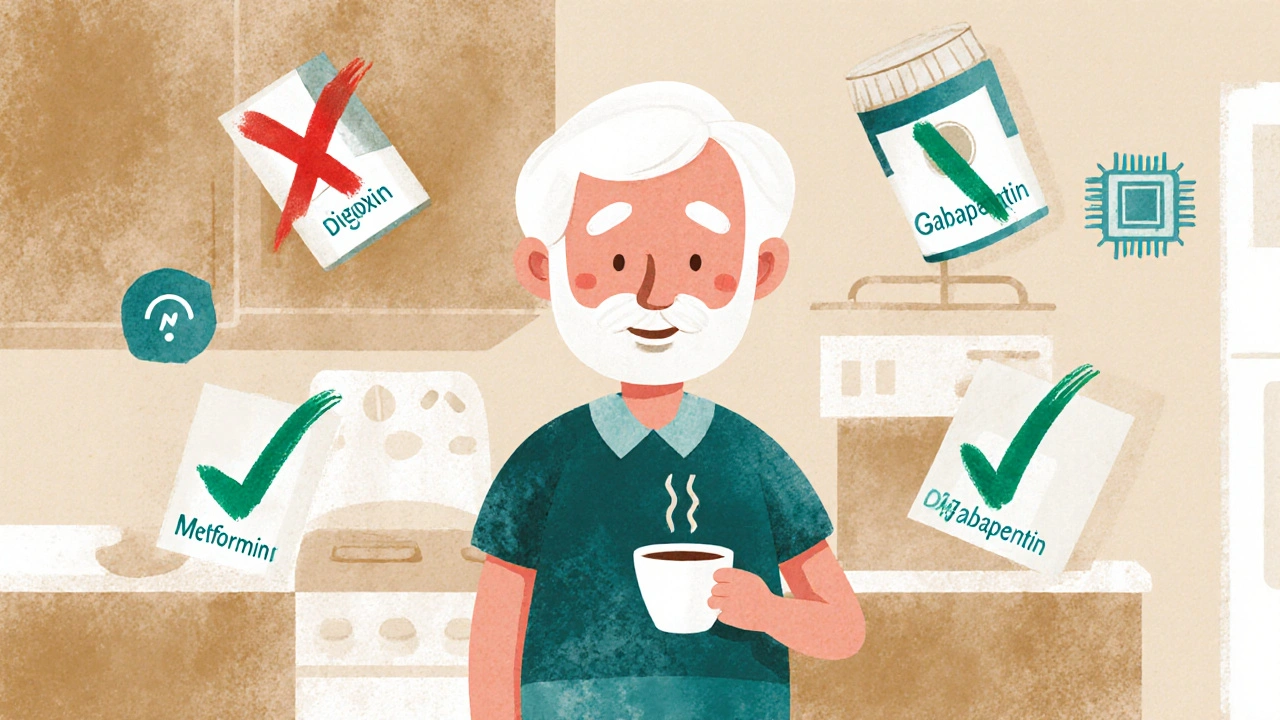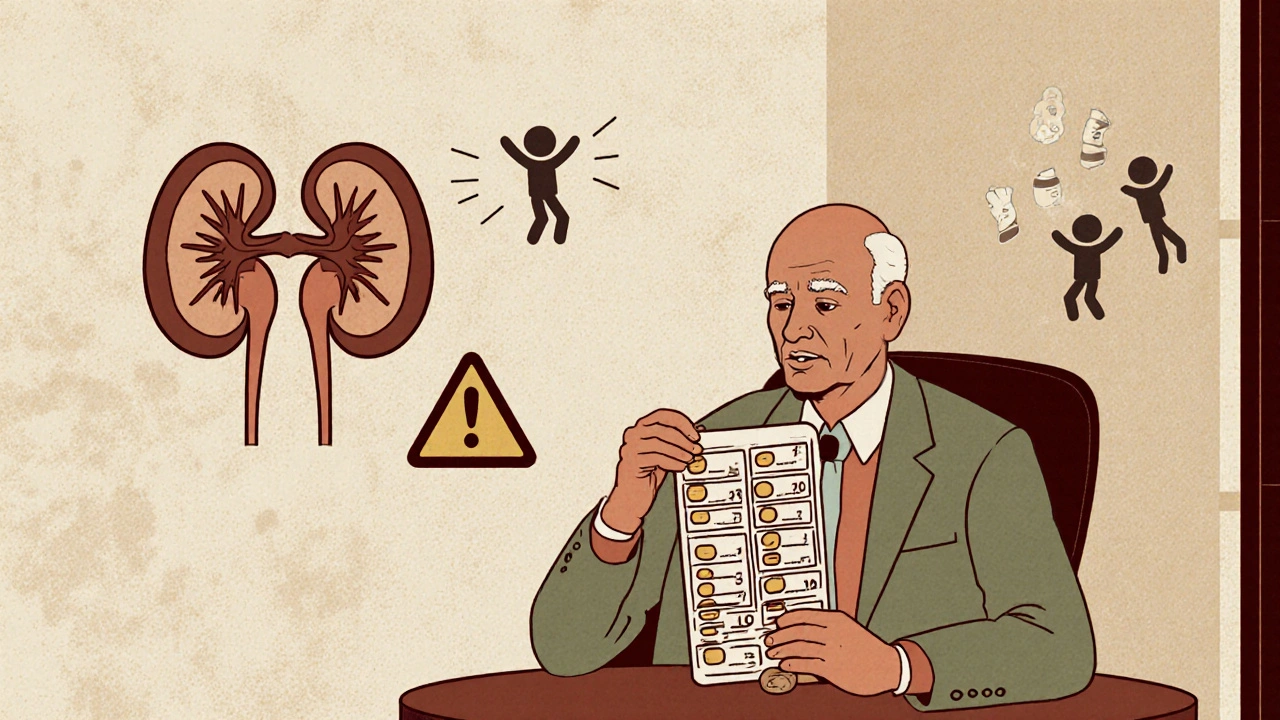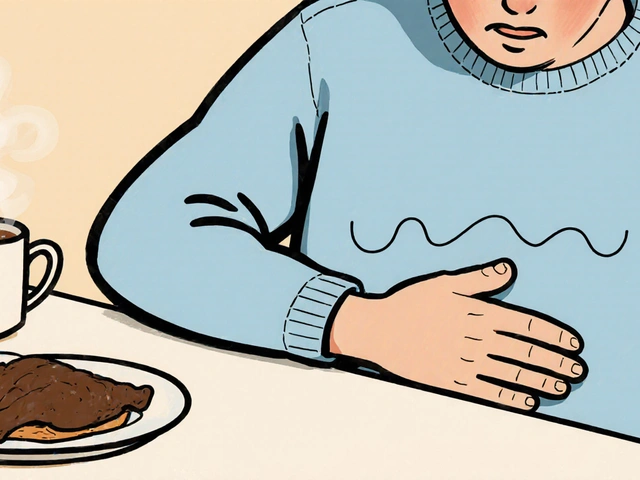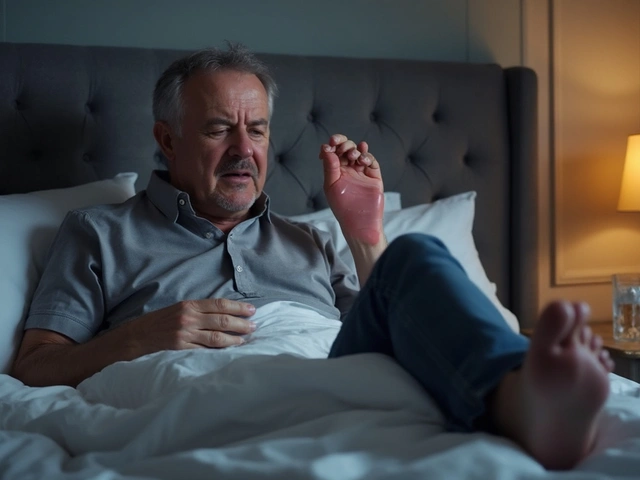Elderly Renal Impairment: How to Adjust Medication Dosing to Prevent Toxicity
Renal Dosing Calculator for Elderly Patients
Calculate Safe Medication Doses
Select your medication and enter kidney function data to determine appropriate dosage for patients over 65.
Results
When you’re over 65 and your kidneys aren’t working like they used to, even a normal dose of a common medication can turn dangerous. It’s not about being old-it’s about how your body changes. Your kidneys filter out drugs, and when they slow down, those drugs build up. That’s when you start feeling dizzy, confused, or weak-not because you’re getting worse, but because your pills are poisoning you.
Why Kidney Function Matters More After 65
About 38% of adults over 65 have chronic kidney disease, according to the National Institute of Diabetes and Digestive and Kidney Diseases. That’s nearly four in ten. But most people don’t know it. Kidney function naturally declines with age. A healthy 30-year-old might have a glomerular filtration rate (GFR) of 90 mL/min/1.73 m². By 75, it’s common to be at 50 or lower. That’s not normal aging-it’s renal impairment.
Drugs like gabapentin, metformin, cefepime, and digoxin leave the body through the kidneys. If your kidneys are slow, those drugs stick around too long. For some, that means seizures. For others, it’s a fall, a hospital stay, or worse. In fact, 12-15% of all serious drug reactions in older adults come from not adjusting doses for kidney function. That’s not rare. That’s routine.
How Doctors Measure Kidney Function (And Why It’s Often Wrong)
Most doctors use a blood test for creatinine and plug it into a formula to estimate kidney function. The two most common formulas are Cockcroft-Gault (CG) and MDRD. But here’s the problem: CG underestimates kidney function in older people by 15-20%. That means if your CG says your CrCl is 40 mL/min, your real kidney function might be 50 or higher. If you reduce your dose based on that, you might not get enough medicine.
MDRD gives you an eGFR. It’s better for younger people, but it’s still not perfect for the elderly. The newest recommendation? Use cystatin C. It’s a different blood marker that doesn’t get thrown off by muscle loss (which is common in older adults). The KDIGO guidelines now suggest using cystatin C-based equations for people over 70, especially if creatinine levels look normal but they’re frail or losing weight.
And weight matters. If you’re overweight, using your actual body weight in the Cockcroft-Gault formula can overestimate kidney function. For obese patients, use adjusted body weight. For underweight or frail seniors, don’t assume they have “normal” muscle mass. That’s where mistakes happen.
Medications That Can Kill If Dosed Wrong
Some drugs are fine in normal doses. Others? One pill too many can land you in the ER.
- Metformin: In the U.S., it’s banned if serum creatinine is above 1.5 mg/dL in men or 1.4 mg/dL in women. In Europe, they’re more flexible-but still require close monitoring. The real danger? Combining metformin with glibenclamide. That combo can cause deadly low blood sugar if your kidneys can’t clear the metabolites.
- Gabapentin: 68% of prescribers get this wrong. Standard dose is 300-1200 mg daily. For CrCl under 30 mL/min, drop it to 100-300 mg daily. Too much? Tremors, drowsiness, falls. One study found 1 in 3 elderly patients on gabapentin had a fall linked to dosing errors.
- Allopurinol: Used for gout. Standard dose is 300 mg daily. For GFR under 10 mL/min, start with 100 mg every other day. Too high? Life-threatening skin reactions.
- Digoxin: Therapeutic range is 0.8-2.0 ng/mL. But in elderly patients with kidney problems, levels can creep up without warning. Check levels 15-20 days after starting, not 5-7. And never assume a “normal” dose is safe.
- Lithium: Narrow window. Too low? Depression returns. Too high? Tremors, confusion, coma. Must be monitored weekly when starting, then every 3 months-even if the patient seems fine.
- Rivaroxaban: An anticoagulant. 52% of dosing errors happen here. Standard is 20 mg daily. For CrCl 15-49 mL/min, drop to 15 mg. Below 15? Don’t use it. Too many doctors still prescribe it at full dose.
And here’s the sneaky part: some drugs aren’t cleared by the kidneys-but their active metabolites are. That’s why metformin-glibenclamide combos are so risky. The metformin gets cleared fine. The glibenclamide turns into a metabolite that lingers. Your kidneys can’t flush it out. So you get hypoglycemia-even if your creatinine looks “okay.”
The 50% Rule: A Dangerous Shortcut
You’ve probably heard it: “If kidney function is below 50 mL/min, cut the dose in half.” It’s simple. But it’s wrong for a lot of drugs.
Vancomycin? It doesn’t follow that rule. Its clearance isn’t linear. Cutting the dose by 50% when CrCl is 40 might still leave you with toxic levels. You need to extend the interval instead-give it every 24 or 48 hours, not reduce the amount.
Piperacillin/tazobactam? The standard is 3.375g every 6 hours. For CrCl 20-50 mL/min, drop to 2.25g every 8 hours. Not half the dose. Not the same interval. A different combo.
The “50% rule” works for some drugs, like gabapentin. But it fails for 22% of high-risk medications. Relying on it is like using a map from 1985 to drive in 2025.
How to Get It Right: Practical Steps
Here’s what works in real clinics:
- Check kidney function before every new prescription. Not just once a year. Every time a new drug is added, especially if it’s for pain, infection, or heart rhythm.
- Use Cockcroft-Gault for elderly patients, even if eGFR looks fine. It’s more conservative and safer.
- Ask: Is this drug cleared by the kidneys? If yes, check the dose. If unsure, look it up. Don’t guess.
- Use a dosing app. Epocrates Renal Dosing, Lexicomp, or UpToDate have built-in calculators. They’re free, fast, and accurate. Download one. Use it.
- Get a pharmacist involved. A 2021 Mayo Clinic study showed that when pharmacists managed dosing for seniors with kidney issues, adverse events dropped by 58%. That’s not a small win. That’s life-saving.
- Watch for signs of toxicity: confusion, dizziness, nausea, swelling, weakness. These aren’t just “getting older.” They’re red flags.

What’s Changing in 2025
AI tools are now helping. DoseOptima, approved by the FDA in 2023, pulls real-time lab data, age, weight, and creatinine from your electronic health record and suggests exact doses for over 150 medications. In trials, it was 92.4% accurate.
KDIGO is releasing an updated guideline in late 2025 that will make cystatin C the preferred test for elderly patients. That’s a big deal. It means creatinine alone won’t cut it anymore.
The American Society of Health-System Pharmacists is finalizing a national standard for renal dosing across 150 high-risk drugs. That means hospitals and pharmacies will have one clear rulebook-no more guessing.
And Medicare is watching. Hospitals that don’t prevent drug toxicity can lose up to 1% of their Medicare payments. That’s $17,000 per bed, per year. Money talks. And now, safety does too.
What You Can Do Right Now
If you or someone you care for is over 65 and taking more than three medications:
- Ask your doctor: “Is this dose right for my kidney function?”
- Request a cystatin C test if creatinine looks normal but you feel off.
- Bring all your meds-pills, patches, supplements-to your next appointment. Don’t trust your memory.
- Ask if a pharmacist can review your list. Many clinics offer free med reviews.
- If you feel dizzy, confused, or unusually tired after starting a new drug-call your doctor. Don’t wait.
This isn’t about being perfect. It’s about being careful. One small change-a lower dose, a longer wait between pills-can mean the difference between staying at home and ending up in the hospital.
What is the best way to estimate kidney function in elderly patients?
For elderly patients, the Cockcroft-Gault equation using actual body weight is the most widely recommended method for dosing decisions. However, if the patient is frail, underweight, or has normal creatinine but signs of kidney issues, a cystatin C-based equation is more accurate. Many experts now recommend using both creatinine and cystatin C together for the clearest picture.
Can I still take metformin if I have kidney impairment?
It depends. In the U.S., metformin is generally avoided if serum creatinine is above 1.5 mg/dL in men or 1.4 mg/dL in women. In Europe, it’s allowed with strict monitoring if eGFR is above 30 mL/min. Always check with your doctor. Never take metformin if you’re dehydrated, sick, or having surgery-your kidneys may not handle it.
Which painkillers are safest for elderly patients with kidney problems?
Acetaminophen (Tylenol) is generally the safest choice for mild to moderate pain. Avoid NSAIDs like ibuprofen or naproxen-they reduce blood flow to the kidneys and can cause sudden kidney injury. Even low-dose aspirin should be used cautiously. Always ask your doctor before starting any new pain medication.
How often should kidney function be checked in elderly patients on medications?
At least once a year for stable patients. But if you’re starting a new medication known to affect the kidneys-like antibiotics, diuretics, or painkillers-check within 2-4 weeks. If you’re on multiple drugs or have diabetes or high blood pressure, check every 3-6 months.
Why do some medications need interval extension instead of dose reduction?
Some drugs, like vancomycin or cefepime, are cleared slowly from the body when kidney function drops. Reducing the dose too much can make the drug ineffective. Instead, keeping the same dose but giving it less often (like every 24 or 48 hours instead of every 6 or 8 hours) keeps levels steady without letting them get too high.






4 Comments
Shannon Amos
November 25 2025So basically, if you’re over 65 and still taking gabapentin like it’s candy, congrats-you’re basically playing Russian roulette with your brain.
And no, ‘I feel fine’ doesn’t count as a lab result.
stephen riyo
November 26 2025Wait-so you’re telling me that doctors are still using Cockcroft-Gault like it’s 2005? And not even adjusting for muscle mass? That’s not negligence-that’s a crime.
And why is no one talking about how insurance won’t cover cystatin C unless you’re dying? It’s like they want us to fall.
Wendy Edwards
November 26 2025My grandma took metformin and glibenclamide for years and never had a problem-until she started getting dizzy and forgot her own name. We found out her CrCl was 38 and she was on full dose.
She’s fine now-dose cut, pharmacist stepped in, and she’s baking cookies again.
Don’t wait until it’s too late. Ask. Ask. ASK.
And if your doctor rolls their eyes? Find a new one. Seriously.
Jaspreet Kaur
November 26 2025Kidneys are not just filters they are the silent poets of the body cleaning the toxins of modern medicine
When we ignore their quiet decline we are not aging we are ignoring wisdom
Medicine treats numbers not people
And people die because numbers look okay
But the body knows
The body always knows